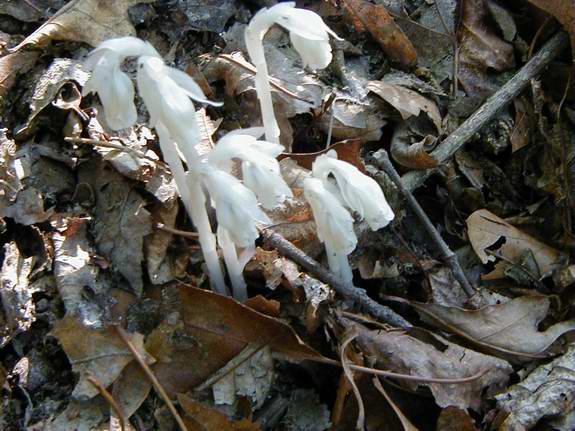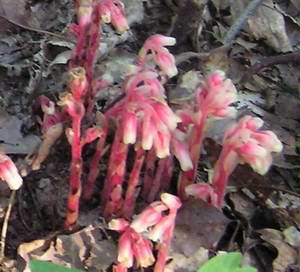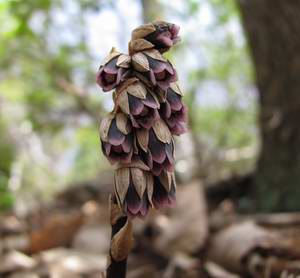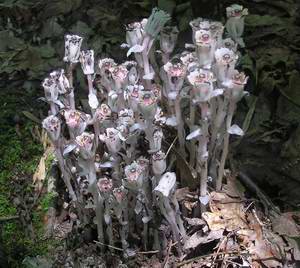|
Return to Hiker's Notebook Home Page
Common Name: Indian Pipe, Corpse plant, Death plant, Ice plant, Ghost flower, Bird's nest, Fairy smoke, Eyebright, Fit plant, Convulsion root - The Indian pipe has the general appearance of the calumet or peace pipe that was used by numerous Native American tribes in ceremonial amity.
Scientific Name: Monotropa uniflora - The generic name comes from the Greek mono meaning 'one' and tropos meaning 'turning' which, according to one interpretation was assigned to characterize the initial downward-turning orientation of the flowers which then turn upwards once the seeds are fertilized. Two other interpretations of 'one turning' are that the flower has a single turn and that the flowers all turn to one side. The singular flower on each stem is the basis for the species name which is Latin for 'one flower.'
The opaline translucence of Indian pipe belies its association with its verdant parent plant family, the Ericaceae, which contains the azaleas, rhododendron and blueberries, among others. It is one of some 3,000 species of plants that do not have chlorophyll and are thus non-photosynthetic and therefore not green. Such plants are called heterotrophs in that, like the animals and the fungi, they must obtain nutrition from a photosynthesizing autotroph. Most of the heterotrophic plants are parasitic, which absorb energy directly from the plant host. What is unusual about Indian pipe is that it is one of about 400 heterotrophs that subsist on a fungus, a relationship that is referred to as mycoheterotrophic or epiparasitic. The epiparasites of the Ericaceae family are in the subfamily Monotropoideae.
Indian pipe is in a nutritional m�nage � trois in that it is connected to a fungus that is in turn in a relationship with a host plant. The mutualistic relationship between a plant and a fungus is called a mycorrhiza; the word originated in the late 19th Century when botanists discovered that plant roots, though infested with fungi, were not in any way damaged or dysfunctional. They described the condition quite simply as "fungus root" and gave it a name derived from the Greek words mykos for fungus and rhizon for root. This relationship is so beneficial that it is estimated that over 90 percent of all plants are mycorrhizal. Those that are not generally fall into the pejorative category of weeds. In a mycorrhizal relationship, the plant supplies the fungus with hexose (six carbon) sugars which are converted into glycogen, a polymer of glucose molecules that can constitute as much as 10 percent of the dry weight of the fungus. In a normal binary mycorrhiza, the fungus supplies the photosynthetic plant with minerals from the soil, primarily phosphorous and nitrogen. Phosphorous is one of the key constituents of adenosine triphosphate (ATP), which, when hydrolyzed to adenosine diphosphate (ADP) is the primary mechanism of plant cell energy generation. Nitrogen is needed for nucleic acids and chitin, the primary fungal cell wall material; proteins are about 15 percent nitrogen. Phosphorous and nitrogen are accessed by the fungus through the creation of an extensive branching underground network of filamentous root-like growths called hyphae. The soil nutrients are scavenged by the hyphae, which are capable of storing soil minerals against a significant concentration gradient. Thus the fungus serves two functions; it searches out critical mineral nutrients over a wide geographic area; and it builds up a reservoir of the minerals for release to the plant when needed. A mycorrhizal fungus can store enough phosphorus to provide a reserve for the tree for about ten days.
In the case of Indian Pipe in particular and the plants of the genus Monotropa in general, the fungus must not only provide phosphorus, nitrogen and other minerals to both the mycorrhizal, photosynthetic host plant and the factitious, epiparasitic plant but it must also serve as a transfer agent for glucose. The Indian Pipe may be thought of as in a reverse mycorrhizal relationship with the fungus as it draws nutrients away contrary to the normal flow from photosynthetic plant to fungus. This is sometimes referred to as epiparasitic cheating. In the complex web of life, it should come as no surprise that only certain fungi will interact with the different species of the Monotropa. A scientific paper published in the journal "Molecular Ecology" in 2001 reported on a study of 10 different species of 331 individual epiparasitic plants that was initiated to establish their fungal symbionts. The study confirmed that these plants, primarily from the genus Monotropa, were all specialized in their association with a different genus of five Basidiomycetes (gilled mushrooms). Specifically, for 10 populations of M. uniflora in Virginia, Oregon, Vermont and Nova Scotia it was found that the all of the fungal symbionts were from the Russula family in the genera Russula and Lactarius. The roots of the Indian pipe are intermingled at the cellular level with the hyphae of the fungus so that the appearance is that of a "Bird's Nest," one of the alternative names for the plant. There are two other
mycoheterotrophic plants that are similar to M. uniflora in habitat and
basic configuration though they differ in coloration. Pinesap is the common
name for Monotropa hypopitys (Greek for 'under pine'); it is also
called False Beechdrops for its similarity in appearance to Beechdrops (Epifagus
virginiana). It is found primarily under pine trees, as the name suggests,
but it is also associated with oak trees. Like the Indian pipe it is
epiparasitic on a fungus that is in a mycorrhizal relationship with the
photosynthetic tree from which it derives nutrients. In the case of pinesap,
the fungus is a member of the Tricholoma family, a large and diverse group of
gilled fungi that basically includes those mushrooms that cannot be assigned
to any other taxonomic grouping. The red coloration of the pinesap above
indicates it to be autumn-flowering, as there is a yellow spring variant that
is a genetically different form of the same species. The second
The reproductive ecology of the Indian Pipe (and the epiparasites in general) is of some interest to botanists due to the unique nature of their nutritional exploitation of mycorrhizal fungi. A report of the reproductive characteristics of the genera Monotropa and Monotropsis was published in the "American Journal of Botany" in 2009 to document the results of a five year long study. It was hypothesized that a plant that was in a mycoheterotrophic relationship with a single species of fungi would need to have a robust and competitive reproduction strategy in order to survive. The relative rarity of the these plants suggests that the obligate fungal association puts a strain on evolutionary viability. The study was undertaken to determine the veracity of the reproductive strategy theory and consisted of the formulation and testing of four hypotheses: (1) that they would have a diversity of pollinators; (2) that they would have the ability to self-pollinate (autogamy); (3) that the flowers would have distinct periods of reproduction that varied from year to year; and (4) that the plants would react to herbivores with a defensive strategy. The results showed that the epiparasitic plants were primarily pollinated by bumblebees (Bombus spp) rather than multiple pollinators and that they were not self-pollinating, contradicting the theory that they would have evolved with autogamous reproduction. The conclusion was that, although monotropes do have variability in periods of flowering and in the reaction to herbivores, the mycoheterotrophic relationship leads to significant limitations in the spread of the genera.
The ethereal appearance of the Indian Pipe with its pallid, bract-covered stem topped by a nodding, equally white flower makes it perhaps the most readily identifiable wildflower. It has earned many metaphorical sobriquets that range from 'Death Plant' to 'Fairy Smoke' to acknowledge this notoriety. It is cool to the touch and is sometimes called 'Ice Plant.' It decomposes into a black, gelatinous mass and is accorded that macabre 'Corpse Plant' for this characteristic. After pollination, the flower extends upward in a 'mono - tropa' or 'one-turning,' the possible basis of the generic name. The seeds are dispensed from this erect posture and must germinate in an area within the purview of the requisite fungus of the Russula family. Therefore, they are rarely spread beyond the immediate vicinity of the parent plant. One typically sees Indian Pipe in epigeal dense clusters directly over the hypogeal Russula fungal mycelium that permeates the rooted soil.
The Indian Pipe did not escape the notice of the Native Americans who used its stem juices in the preparation of a treatment for sore or inflamed eyes (whence the name 'Eyebright'), as a topical application for warts and bunions, and to ameliorate general aches and pains. The early colonists adopted these practices and extended them to the use of the powdered root in the treatment of a variety of ailments, notably Saint Vitus' Dance or chorea, a nervous condition characterized by irregular, jerking movements. The common names 'Fit Root' and 'Convulsion Root' are vestiges of this practice. Physicians at one time administered a tonic that was used as a general sedative for any nervous or restless condition. It is not known if any of these treatments were anything more than a placebo; modern medicinal plant guides generally warn of possible toxicity due to the presence of glycosides.
Indian Pipe is seen as either satanic and angelic according to individual perceptions. Nellie Blanchan de Graff, a noted nature writer and scientific historian of the late nineteenth century, offered the opinion that " � no wonder it grows black with shame on being picked, as if its wickedness was just being discovered." In contrast, Mary Higgenson, the second wife of the noted Massachusetts abolitionist Thomas Wentworth Higgenson who commanded the first regiment of freed slaves in the Civil War, thought so much of the plant that she wrote the poem "Ghost Flowers" in tribute. The flowers are metaphor to a 'spotless sisterhood' engaged in their 'shy devotions near the singing brook' whose 'heads are bent, as if in prayerful mood." Whether considered foul or fait, Monotropa uniflora ranks as one of the true wonders of the forest world. |


 ndian-pipe
like mycoheterotrophic plant is the relatively rare Monotropsis
(resembling Monotropa) odorata, commonly known as Sweet Pinesap
or Pygmy Pipes. The fragrance of the flowers signified by the odoriferous
species name is manifest only in the earlier of its two flowering periods
from February to April. It is odorless in the later, September fluorescence.
The fungal associate in the genus Hydnellum is not as well defined as
those of the two monotropes, since it is based on only one population of two
plants in North Carolina. The picture of Sweet Pinesap was taken just south of
Old Rag Mountain by David Cox.
ndian-pipe
like mycoheterotrophic plant is the relatively rare Monotropsis
(resembling Monotropa) odorata, commonly known as Sweet Pinesap
or Pygmy Pipes. The fragrance of the flowers signified by the odoriferous
species name is manifest only in the earlier of its two flowering periods
from February to April. It is odorless in the later, September fluorescence.
The fungal associate in the genus Hydnellum is not as well defined as
those of the two monotropes, since it is based on only one population of two
plants in North Carolina. The picture of Sweet Pinesap was taken just south of
Old Rag Mountain by David Cox.